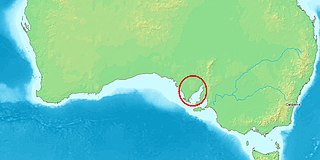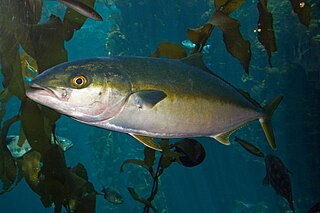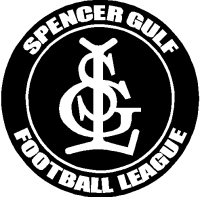
Whyalla is a city in South Australia. It was founded as "Hummocks Hill", and was known by that name until 1916. It is the fourth most populous city in the Australian state of South Australia after Adelaide, Mount Gambier and Gawler and along with Port Pirie and Port Augusta is one of the three towns to make up the Iron Triangle. As of June 2018, Whyalla had an urban population of 21,742, having declined at an average annual rate of -0.75% year-over-year over the preceding five years. It is a seaport located on the east coast of the Eyre Peninsula and is known as the "Steel City" due to its integrated steelworks and shipbuilding heritage. The port of Whyalla has been exporting iron ore since 1903.

The Spencer Gulf is the westernmost and larger of two large inlets on the southern coast of Australia, in the state of South Australia, facing the Great Australian Bight. It spans from the Cape Catastrophe and Eyre Peninsula in the west to Cape Spencer and Yorke Peninsula in the east.

Port Augusta is a coastal city in South Australia about 310 kilometres (190 mi) by road from the state capital, Adelaide. Most of the city is on the eastern shores of Spencer Gulf, immediately south of the gulf's head, comprising the city's centre and surrounding suburbs, Stirling North, and seaside homes at Commissariat Point, Blanche Harbor and Miranda. The suburb of Port Augusta West is on the western side of the gulf on the Eyre Peninsula. Together, these localities had a population of 13,515 people in the 2021 census.

GTS/BKN are Australian regional television stations serving the Spencer Gulf of South Australia and the Broken Hill area of New South Wales.

The Eyre Peninsula is a triangular peninsula in South Australia. It is bounded by the Spencer Gulf on the east, the Great Australian Bight on the west, and the Gawler Ranges to the north.

Port Broughton is a small South Australian town located at the northern extent of the Yorke Peninsula on the east coast of Spencer Gulf. It is situated about 170 km north-west of Adelaide, and 56 km south of Port Pirie. At the 2016 census, the town of Port Broughton had a population of 1,034.
Arno Bay is a small fishing and tourist town on the east coast of Eyre Peninsula in South Australia, located on the Lincoln Highway about halfway between Whyalla and Port Lincoln. First proclaimed under the name Bligh in 1883, the current name dates back to 1940. It is a recreational town with a number of marine and nature based attractions, including fishing, surfing and swimming.

The yellowtail amberjack, yellowtail kingfish, hiramasa or great amberjack is a large fish found in the Southern Ocean. Although previously thought to be found in all oceans and seas, recent genetic analysis restricts S. lalandi proper to the Southern Hemisphere waters. However, they are found in Northern Hemisphere waters during certain times of the year. The fish was given its name by Monsieur de Lalande, a naturalist who first informed zoologist Achille Valenciennes of the existence of this species. His reason for the use of the word Seriola to name the fish is uncertain, but the second word lalandi was derived from his surname.

The giant cuttlefish, also known as the Australian giant cuttlefish, is the world's largest cuttlefish species, growing to 50 cm (20 in) in mantle length and up to 100 cm (39 in) in total length. They can be over 10.5 kg (23 lb) in weight. Like all cuttlefish species, the giant cuttlefish has 8 arms and 2 feeding tentacles, as well as blue blood and 3 hearts. Using cells known as chromatophores, the cuttlefish can put on spectacular displays, changing colour in an instant. The giant cuttlefish is native to temperate and subtropical waters of Australia, from Brisbane in Queensland to Shark Bay in Western Australia and Tasmania to the south. It occurs on rocky reefs, seagrass beds, and sand and mud seafloor to a depth of 100 m (330 ft). In 2009 the species was listed at Near Threatened on the IUCN Red List of Threatened Species due to an observed declining trend at that time.

The Spencer Gulf Football League is an Australian rules football competition based at the head of the Spencer Gulf in South Australia. It is an affiliated member of the South Australian National Football League.

Port Bonython is the location of a deepwater port, gas fractionation plant and diesel storage facility west of Point Lowly in the Upper Spencer Gulf region of South Australia. It lies 16 km east-northeast of Whyalla, South Australia and approximately 370 km north-west of the State's capital city, Adelaide. The existing wharf is 2.4 kilometres long and is capable of berthing small Capesize ships with a maximum capacity of 110,000 tonnes. The wharf was established in 1982 and named after John Bonython, the founding chairman of Santos. The structure is leased to Santos by the Government of South Australia and is used for the export of hydrocarbon products. An oil spill at Port Bonython in 1992 resulted in loss of bird life and damage to mangrove habitats to the west and southwest of Port Pirie.

Point Lowly is the tip of a small peninsula north north-east of Whyalla in the Upper Spencer Gulf region of South Australia. The wider peninsula is shared by a combination of defence, industrial, residential, recreational and tourism interests. Port Bonython lies immediately to the north-west and is marked for future industrial expansion, driven by anticipated growth in the State's mining industry. The icons of the peninsula are the historic Point Lowly Lighthouse and the mass breeding aggregation of Australian giant cuttlefish which occurs inshore each winter.

The Point Lowly lighthouse was constructed in 1883 to guide ships safely through Spencer Gulf en route to Port Augusta and Port Pirie in South Australia. It was upgraded several times before being deactivated in 1993. It was reactivated in 1995 and is a tourist attraction for the Whyalla area and an icon of the Point Lowly area.
Curlew Island is a low mangrove-dominated island located near the head of Spencer Gulf, South Australia. It lies between Port Augusta and Point Lowly and is adjacent to the Playford B Power Station. Several ships ran aground in the shallow waters surrounding the island during the late 1800s and early 1900s. Several recreational boating accidents have also occurred in the vicinity. The locality is known for its fishing and for occasional whale sightings in the winter.

The Morgan – Whyalla pipeline was an engineering project undertaken by the South Australian Government in 1940 to bring water from Morgan on the River Murray to the industrial city of Whyalla. A second pipeline, by a divergent route, was laid in the 1960s.
Craig Foster is the CEO of Clean Seas, an ASX-listed Australian seafood company with interests in southern bluefin tuna and yellowtail kingfish farming. He was appointed to the position in 2012 after working in the salmon farming industry in Tasmania. There he managed research and development at the state's largest salmon hatchery and also worked as the Managing Director of fish feed producer, Gibsons Ltd. In 2001, he was working for Pivot, and assisting in the development of barramundi farms in the Northern Territory.

Clean Seas Seafood Ltd is an Australian seafood company, specialising in aquaculture of the Yellowtail Kingfish.
Fish farming inWestern Australia is an experimental part of the state's seafood sector. Prominent operators and lessees include Indian Ocean Fresh Australia and Huon Aquaculture, and the primary commercial species are yellowtail kingfish in the Mid West aquaculture zone and barramundi in the Kimberley aquaculture zone. Pink snapper is another species considered as a sea cage fish farming prospect. The Mid West aquaculture zone lies between Geraldton and the Abrolhos Islands, and the Kimberly aquaculture zone is in Cone Bay north of Derby. The sector is represented by Erica Starling as spokesperson for the Marine Fishfarmers Association.
Fish farming is a major economic contributor to South Australia's seafood sector. The most valuable species is the Southern bluefin tuna, which is caught in the wild then transferred into sea cages in southern Spencer Gulf where they are fed locally caught sardines. The second most valuable species is the Yellowtail kingfish, which is farmed near Port Lincoln and Arno Bay. A tourist venture called Oceanic Victor located in Encounter Bay allows paying customers the opportunity to swim in a sea cage with the Southern bluefin tuna and handfeed the fish. Prominent companies in the fish farming sector in South Australia include Clean Seas and Tony's Tuna International.

Spilsby Island is one of the largest islands in the Sir Joseph Banks Group in Spencer Gulf, South Australia. It is privately owned, has no permanent human residents and is grazed by sheep. The island was used for the breeding of sheep by James Hunter Kerrison, then for the breeding of horses, sheep, pigs and cattle by W. E. Scruby in the early 20th century. Shearers travelled to the island to shear the sheep. The island's soil has been enriched by the deposition of guano by seabirds. Land allotments and a few shacks are concentrated along the northern coast of the island. Butterfish Bay is on the northern coast and Hawknest Bay is on the eastern coast.















